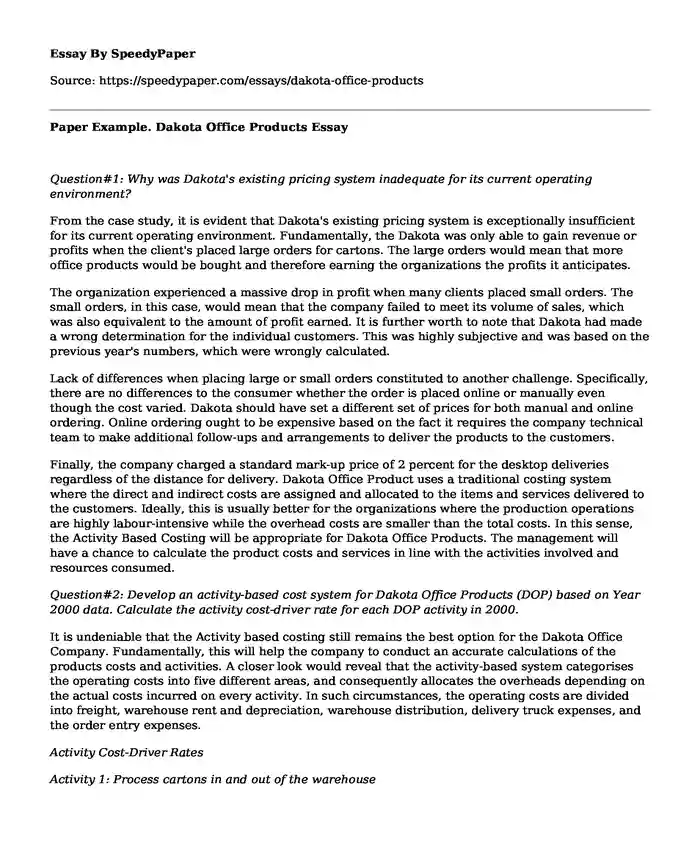
| Type of paper: | Case study |
| Categories: | Accounting Business management Financial analysis |
| Pages: | 3 |
| Wordcount: | 672 words |
Question#1: Why was Dakota's existing pricing system inadequate for its current operating environment?
From the case study, it is evident that Dakota's existing pricing system is exceptionally insufficient for its current operating environment. Fundamentally, the Dakota was only able to gain revenue or profits when the client's placed large orders for cartons. The large orders would mean that more office products would be bought and therefore earning the organizations the profits it anticipates.
The organization experienced a massive drop in profit when many clients placed small orders. The small orders, in this case, would mean that the company failed to meet its volume of sales, which was also equivalent to the amount of profit earned. It is further worth to note that Dakota had made a wrong determination for the individual customers. This was highly subjective and was based on the previous year's numbers, which were wrongly calculated.
Lack of differences when placing large or small orders constituted to another challenge. Specifically, there are no differences to the consumer whether the order is placed online or manually even though the cost varied. Dakota should have set a different set of prices for both manual and online ordering. Online ordering ought to be expensive based on the fact it requires the company technical team to make additional follow-ups and arrangements to deliver the products to the customers.
Finally, the company charged a standard mark-up price of 2 percent for the desktop deliveries regardless of the distance for delivery. Dakota Office Product uses a traditional costing system where the direct and indirect costs are assigned and allocated to the items and services delivered to the customers. Ideally, this is usually better for the organizations where the production operations are highly labour-intensive while the overhead costs are smaller than the total costs. In this sense, the Activity Based Costing will be appropriate for Dakota Office Products. The management will have a chance to calculate the product costs and services in line with the activities involved and resources consumed.
Question#2: Develop an activity-based cost system for Dakota Office Products (DOP) based on Year 2000 data. Calculate the activity cost-driver rate for each DOP activity in 2000.
It is undeniable that the Activity based costing still remains the best option for the Dakota Office Company. Fundamentally, this will help the company to conduct an accurate calculations of the products costs and activities. A closer look would reveal that the activity-based system categorises the operating costs into five different areas, and consequently allocates the overheads depending on the actual costs incurred on every activity. In such circumstances, the operating costs are divided into freight, warehouse rent and depreciation, warehouse distribution, delivery truck expenses, and the order entry expenses.
Activity Cost-Driver Rates
Activity 1: Process cartons in and out of the warehouse
Rate= (90% of Warehouse Personnel Expense+ Cost of Items bought)/Cartons processed
Rate= (90%*2,400,000+35,000,000)/80,000=$464.5/per carton
Activity Two: The Desktop delivery services
Rate= (10% of Warehouse Personnel Expense Delivery Truck Expenses)/Desktop deliveries
Rate= (10%*2,400,000+200,000)/2000=$220/ per carton.
Activity Three: Order handling
Rate= (Warehouse Expenses+ Freight)/Order quantity
Rate= (2,000,000+450,000)/ (16,000+8,000) = $102.08/per order
From the case study, it becomes evident that the cost rate of processing cartons was determined through the distribution of the warehouse expense and warehouse expense personnel over the total number of the shipped cartons.
The cost rate of freight was determined through the distribution of the total freight expense over the total number of cartons shipped through the freight.
The cost rate of delivery of desktops was determined through the distribution of the delivery truck expenses as well as the warehouse personnel expense.
The cost rate of the manual orders was established through the distribution of order entry expenses (weighted by 20 percent time allocation) over the entire number of manual orders processed.
The cost rate of line products was established through the dispersal of orders entry expenses (weighted 75 percent time allocation) over a total number of office products processed.
The EDI cost rate was established through the distribution of order entry expenses (weighted by 5% time allocation) over the total number of EDI orders obtained.
Cite this page
Paper Example. Dakota Office Products. (2023, Feb 22). Retrieved from https://speedypaper.com/essays/dakota-office-products
Request Removal
If you are the original author of this essay and no longer wish to have it published on the SpeedyPaper website, please click below to request its removal:
- Essay Example on the Internet Security Issue
- Robin Hood and Management, Business Essay Sample
- Free Essay About The First Intifada
- Generating Value - Free Essay about Nissan Company Case Study
- Essay Sample on Updike's A & P
- Free Essay Example: Faction Groups
- International Strategy Issues - Free Essay Sample
Popular categories




